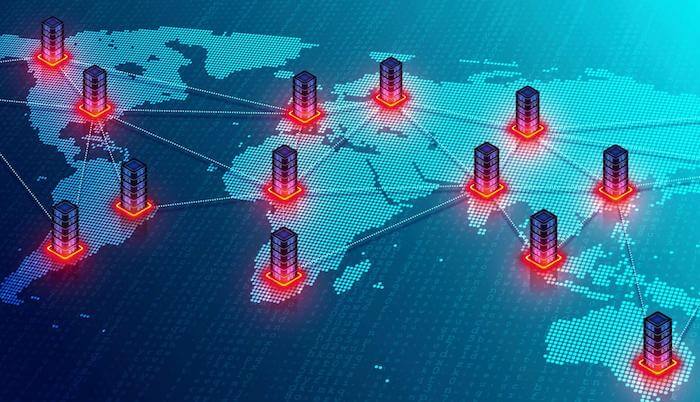
As more devices become connected, the need for real-time data processing and analysis has also grown. Edge computing has emerged as a solution to this need.
In this blog post, we will introduce the concept of edge computing, explain its key components, outline its advantages and use cases, and discuss its challenges and limitations.
We will explore its architecture and its differences from cloud computing. Finally, we will discuss the future of edge computing and its potential impact on industries and society.
So let’s begin!
What is Edge Computing?
Edge computing is a distributed computing model that brings data processing closer to the source of the data (the edge), such as sensors or IoT devices. In edge computing, data processing takes place on local devices, rather than on a centralized server or in the cloud. This approach is useful in situations where low latency and real-time data processing are critical. It typically consists of three main components: sensors, gateways, and edge servers.
A. Sensors
Sensors are devices that collect data at the edge of a network. These devices can be anything from temperature sensors to video cameras to microphones. Sensors are usually connected to IoT devices that allow them to communicate with gateways.
B. Gateways
Gateways are devices that receive data from sensors and transmit it to edge servers. They act as intermediaries between sensors and edge servers. Gateways can also perform preprocessing and filtering of data before transmitting it to edge servers.
C. Edge Servers
Edge servers are the devices that process data at the edge of a network. These devices can be anything from servers to smartphones. Edge servers process data in real-time and can store processed data for later use.
Edge Computing Architecture
The architecture typically consists of four layers: devices, edge gateway, edge nodes, and cloud.
Devices are the source of data in edge computing, and they include sensors, IoT devices, and other hardware that generates data. The devices collect and transmit data to the edge gateway.
The edge gateway serves as the bridge between the devices and the edge nodes. It collects data from the devices, processes it, and sends it to the appropriate edge nodes. The edge gateway is responsible for performing the initial processing of data, filtering, and aggregating it before forwarding it to the edge nodes.
Edge nodes are the computing resources that process data and run applications at the edge of the network. They are located closer to the devices and are responsible for performing real-time processing of data. Edge nodes are designed to handle the low-latency demands of edge computing.
Cloud is the final component of the edge computing architecture. Cloud computing resources are used for more extensive data processing, long-term storage, and analytics. The cloud is responsible for managing and processing data that has been aggregated and sent from the edge nodes.
The architecture is distributed, with each component located at a different level of the network. The devices are located at the lowest level, followed by the edge gateway, the edge nodes, and the cloud at the highest level. The architecture allows for real-time data processing, reduced network traffic, and improved overall performance.
One example of edge architecture is the Amazon AWS Greengrass platform. This platform allows for local data processing on IoT devices using edge nodes, which can communicate with AWS cloud services for further analysis and storage.
Related: IaaS vs SaaS vs PaaS: Introduction to Cloud Computing Models
Advantages of Edge Computing
A. Reduced Latency
Edge computing reduces latency by processing data locally instead of transmitting it to a centralized server for processing. This results in faster response times and improved performance.
B. Improved Reliability
It improves reliability by reducing the risk of data loss. Since data is processed locally, it is less vulnerable to network outages or disruptions. Additionally, edge servers can store processed data locally, reducing the risk of data loss due to network failures.
C. Increased Security
It increases security by reducing the risk of data breaches. Since data is processed locally, it is less vulnerable to cyber-attacks or breaches. Additionally, edge servers can store processed data locally, reducing the risk of data breaches due to network failures.
D. Reduced Bandwidth Requirements
Edge computing reduces bandwidth requirements by processing data locally. This reduces the amount of data that needs to be transmitted to centralized servers, resulting in lower bandwidth usage.
E. Increased Efficiency
It increases efficiency by reducing the workload on centralized servers. Since data is processed locally, it reduces the amount of data that needs to be transmitted to centralized servers, reducing the workload on these servers.
Use Cases for Edge Computing
A. Internet of Things (IoT) Devices
Edge computing is particularly useful for IoT devices that generate large amounts of data. By processing data locally, it reduces latency and improves performance, making it ideal for IoT applications such as smart homes, smart cities, and industrial IoT.
Put Your Tech Company on the Map!
Get featured on Nicholas Idoko’s Blog for just $50. Showcase your business, boost credibility, and reach a growing audience eager for tech solutions.
Publish NowB. Autonomous Vehicles
It is also useful for autonomous vehicles, where real-time data processing is critical. Edge servers can process data from sensors in real-time, allowing for rapid decision-making and reducing the risk of accidents.
C. Smart Cities
Smart cities use it to monitor and manage infrastructure such as traffic lights, streetlights, and waste management systems. By processing data locally, edge computing reduces latency and allows for real-time monitoring and decision-making.
D. Healthcare
Edge computing is also used in healthcare for remote patient monitoring and diagnosis. Edge servers can process data from sensors such as wearables or medical devices in real-time, allowing for faster and more accurate diagnosis and treatment.
E. Retail
Retail stores use it for inventory management, real-time pricing, and personalized customer experiences. This allows for faster and more accurate decision-making, improving customer experiences and reducing costs.
F. Manufacturing
Edge computing is used in manufacturing for real-time monitoring and predictive maintenance. Edge servers can process data from sensors in real-time, allowing for rapid identification of issues and reducing downtime.
Challenges and Limitations of Edge Computing
A. Computing Power Limitations
Edge servers typically have less computing power than centralized servers, which can limit the complexity of data processing that can be done at the edge. This can result in less accurate data processing and analysis.
B. Network Connectivity Limitations
Edge computing relies on network connectivity to transmit data to and from edge servers. This can be a limitation in areas with poor network connectivity, such as remote locations or areas with weak cellular signals.
C. Security Concerns
Since edge computing relies on local devices for data processing, there are concerns about the security of these devices. These devices can be vulnerable to cyber-attacks or breaches, resulting in data loss or theft.
D. Integration with Existing Systems
Integrating edge computing with existing systems can be a challenge. This can be due to differences in protocols or data formats, as well as compatibility issues with legacy systems.
Edge Computing vs. Cloud Computing
While both are used for data processing and analysis, they have some key differences. The primary difference is the location of the data processing.
In cloud computing, data processing takes place on centralized servers that are located remotely. In contrast, in edge computing, data processing takes place on local devices that are closer to the source of the data.
Edge computing is therefore helpful in situations where low latency and real-time data processing are critical, while cloud computing is useful in cases where data storage and data processing can be done remotely.
When to Use Edge Computing vs. Cloud Computing
The decision to use edge computing or cloud computing depends on the specific requirements of the use case or application.
In general, edge computing is useful in situations where low latency and real-time data processing are critical. Applications such as autonomous vehicles, industrial automation, and remote patient monitoring.
In these applications, data must be processed quickly, and even a few seconds of latency can cause significant problems. It allows data processing to occur closer to the source of the data, reducing latency and improving overall performance.
Cloud computing is useful for applications that require large-scale data processing, such as big data analytics, machine learning, and scientific simulations. In these applications, data can be processed remotely on large-scale computing resources, allowing for high-performance computing and scalability.
Future of Edge Computing
The future of edge computing is bright, with experts predicting significant growth in the coming years. The increased adoption of IoT devices and the need for real-time data processing are driving its growth. Advancements in technology, such as 5G networks and AI, are also expected to further its adoption.
The potential impact of edge computing on industries and society is significant. It can improve efficiency, reduce costs, and improve customer experiences in industries such as healthcare, retail, and manufacturing. Additionally, it can improve safety and reduce accidents in industries such as autonomous vehicles.
Conclusion
Edge computing is an innovative distributed computing model that allows for real-time data processing and reduced latency. Although it has challenges and limitations, such as computing power and security concerns, the future of edge computing is bright with technological advancements like 5G networks and AI.
Its potential impact on industries and society is significant, with the potential to improve efficiency, reduce costs, and improve customer experiences while increasing safety. As more industries adopt it, we can expect to see significant advancements in various fields.
Before you go…
Hey, thank you for reading this blog to the end. I hope it was helpful. Let me tell you a little bit about Nicholas Idoko Technologies. We help businesses and companies build an online presence by developing web, mobile, desktop, and blockchain applications.
We also help aspiring software developers and programmers learn the skills they need to have a successful career. Take your first step to becoming a programming boss by joining our Learn To Code academy today!
Be sure to contact us if you need more information or have any questions! We are readily available.
[E-Books for Sale]
1,500 AI Applications for Next-Level Growth: Unleash the Potential for Wealth and Innovation
Put Your Tech Company on the Map!
Get featured on Nicholas Idoko’s Blog for just $50. Showcase your business, boost credibility, and reach a growing audience eager for tech solutions.
Publish Now$5.38 • 1,500 AI Applications • 228 pages
Are you ready to tap into the power of Artificial Intelligence without the tech jargon and endless guesswork? This definitive e-book unlocks 1,500 real-world AI strategies that can help you.
See All 1,500 AI Applications of this E-Book
750 Lucrative Business Ideas: Your Ultimate Guide to Thriving in the U.S. Market
$49 • 750 Business Ideas • 109 pages
Unlock 750 profitable business ideas to transform your future. Discover the ultimate guide for aspiring entrepreneurs today!
See All 750 Business Ideas of this E-Book
500 Cutting-Edge Tech Startup Ideas for 2024 & 2025: Innovate, Create, Dominate
$19.99 • 500 Tech Startup Ideas • 62 pages
You will get inspired with 500 innovative tech startup ideas for 2024 and 2025, complete with concise descriptions to help you kickstart your entrepreneurial journey in AI, Blockchain, IoT, Fintech, and AR/VR.
We Design & Develop Websites, Android & iOS Apps
Looking to transform your digital presence? We specialize in creating stunning websites and powerful mobile apps for Android and iOS. Let us bring your vision to life with innovative, tailored solutions!
Get Started Today



